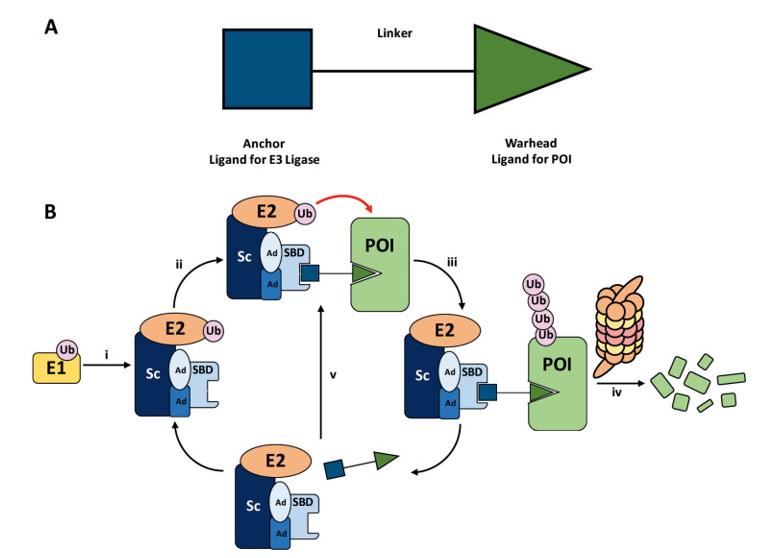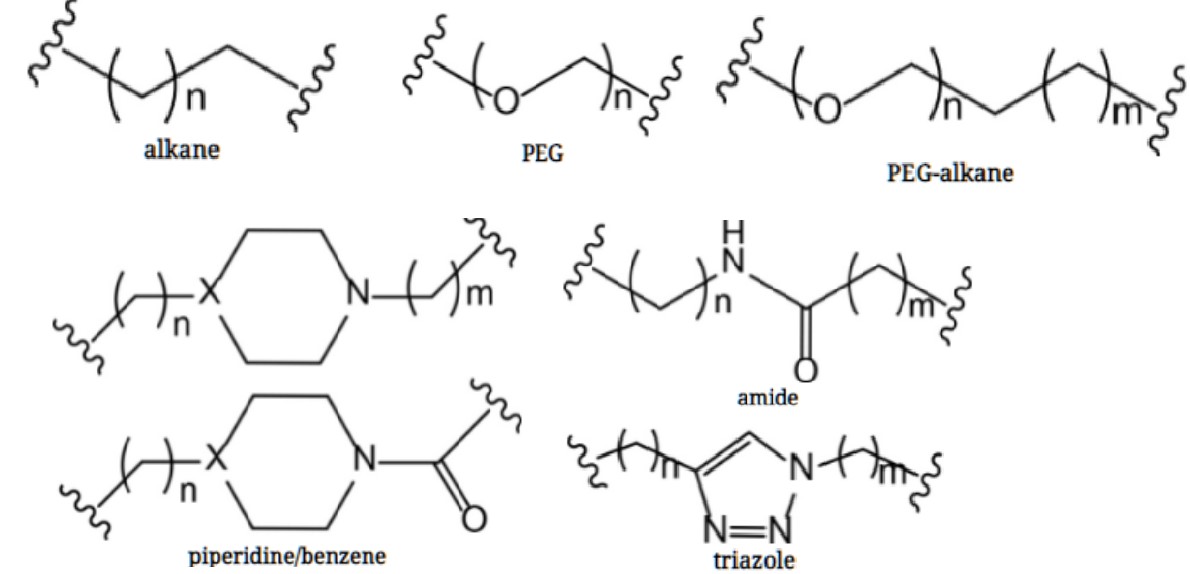Introduction
Proteolysis targeting chimera (PROTAC) building blocks are a series of compounds used to synthesize PROTAC. PROTAC is heterobifunctional compound, which is comprised of a protein-targeting ligand (also known as “warhead”), an appropriate linker, and a ligand (also known as “anchor”) binding to the E3 ligase of choice. Therefore, PROTAC building blocks can be roughly divided into the following categories: E3 ligase ligand, PROTAC linker, ligand for target protein for PROTAC, E3 ligase ligand-linker conjugate, target protein ligand-linker conjugate, etc. PROTAC has emerged as a novel therapeutic modality in drug discovery. It mediates the degradation of select proteins of interest (POIs) by hijacking the activity of E3 ubiquitin ligases for POI ubiquitination and subsequent degradation by the 26S proteasome[1]. This hijacking mechanism has been used to remove various types of disease-causing proteins, including cancer, viral infection, immune disorders, and neurodegenerative diseases, to achieve the purpose of curing disease. At the same time, PROTAC has prominent advantages of overcoming drug resistance of cancer, eliminating both the enzymatic and nonenzymatic functions of kinase, degradation of “undruggable” protein target, and fast and reversible chemical knockdown strategy in vivo[2], and thus bring unprecedented opportunities to pharmaceutical and biotechnology fields. Therefore, as an essential material of the synthesis of PROTAC compound, building blocks of PROTAC molecule have gained great attention from academia and industry.
 Fig. 1. (A) General structure of a PROTAC and (B) mechanism of PROTAC-mediated target degradation.
Fig. 1. (A) General structure of a PROTAC and (B) mechanism of PROTAC-mediated target degradation.
Types of PROTAC Building Blocks
Here, several typical PROTAC building blocks are described as follows:
- E3 Ligase Ligands: Even though there are over 600 types of E3 ligases in human cells, only a very limited number of E3 ligases have been used for PROTAC technology, including Cereblon (CRBN), Von Hippel–Lindau (VHL), inhibitors of apoptosis proteins (IAP), and mouse double minute 2 homolog (MDM2) protein. Therefore, the commonly used E3 ligase ligands include CRBN ligands, VHL ligands, IAP ligands and MDM2 ligands. Known CRBN ligands include thalidomide and other derived immunomodulatory imide drugs (IMiDs). Many VIH ligands have been synthesized, and their synthesis strategies include connection via an amide bond after the amino acid tert-leucine, phenolic linkage point at the benzene ring, link via a thioether at the left-hand side amino acid, and via the benzylic methylene group. Known IAP ligands include methyl bestatin derivative, MV1 derivative, LCL-161 derivative, etc. Known MDM2 ligands include nutlin-3a derivative, idasanutlin derivative, RG7112-derivative and MI-1061 derivative[3].
 Fig. 2. CRBN, VHL and IAP ligands and their frequency used in PROTAC compounds.
Fig. 2. CRBN, VHL and IAP ligands and their frequency used in PROTAC compounds.
- PROTAC Linker: PROTAC linker is the connecting unit between the E3 ligand and the target protein-ligand. The frequently used linkers in PROTAC design are PEG and (un)saturated alkane chains with varying lengths up to now. And more than half of the published PROTAC structure contained alkyl and PEG motifs. The alkyl chains containing heteroatoms (oxygen atoms or nitrogen atoms) have improved hydrophilicity over alkyl chains alone which may increase the cell permeability of PROTAC, and thus having a wider application than the alkyl chain alone. More recently, linear linkers are gradually replaced by rigid linkers, such as alkynes and saturated heterocycles (piperazine and piperidine) because the incorporation of aromatic rings or alkyne chains imparts some rigidity and promotes stable ternary complex formation[4].
 Fig. 3. The common types of linkers for design of PROTAC.
Fig. 3. The common types of linkers for design of PROTAC.
- Ligand for Target Protein for PROTAC: At present, the commonly used PROTAC ligands for target protein are mostly based on known inhibitors/agonists, and the targets are mostly cancer-related proteins. The target protein ligands can be used in virtual screening and high-throughput screening methods without considering competitive binding.
Our company offers a series of PROTAC building blocks, including E3 ligase ligand, PROTAC linker, ligand for target protein for PROTAC, E3 ligase ligand-linker conjugate, target protein ligand-linker conjugate, etc. You can click on our product list for a detailed view. At the same time, we also offer product customization according to customer's detailed requirements. If you are interested in our products or have any questions or needs, please feel free to contact us. We will be happy to provide you with support and services.
References
- Paiva S. L. and Crews C. M. Targeted protein degradation: elements of PROTAC design[J]. Current opinion in chemical biology, 2019, 50: 111-119.
- Gao H., et al. PROTAC technology: opportunities and challenges[J]. ACS medicinal chemistry letters, 2020, 11(3): 237-240.
- Bricelj A., et al. E3 ligase ligands in successful PROTACs: an overview of syntheses and linker attachment points[J]. Frontiers in chemistry, 2021, 9: 707317.
- Liu Z., et al. An overview of PROTACs: a promising drug discovery paradigm[J]. Molecular Biomedicine, 2022, 3(1): 46.
Related Products
It should be noted that our service is only used for research, not for clinical use.

 Fig. 1. (A) General structure of a PROTAC and (B) mechanism of PROTAC-mediated target degradation.
Fig. 1. (A) General structure of a PROTAC and (B) mechanism of PROTAC-mediated target degradation. Fig. 2. CRBN, VHL and IAP ligands and their frequency used in PROTAC compounds.
Fig. 2. CRBN, VHL and IAP ligands and their frequency used in PROTAC compounds. Fig. 3. The common types of linkers for design of PROTAC.
Fig. 3. The common types of linkers for design of PROTAC.